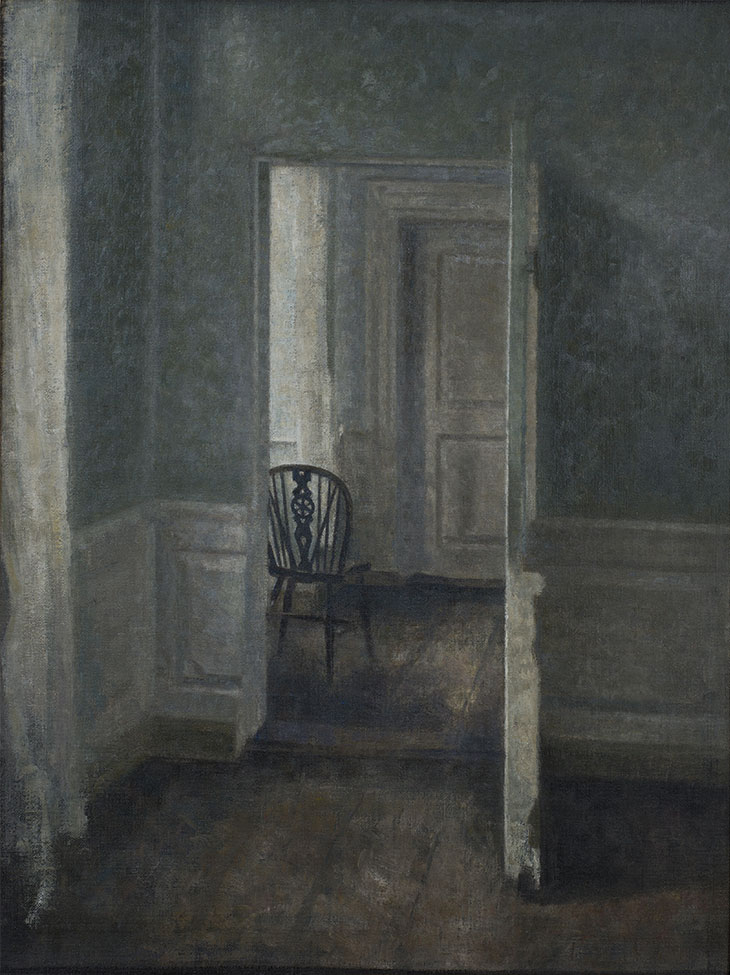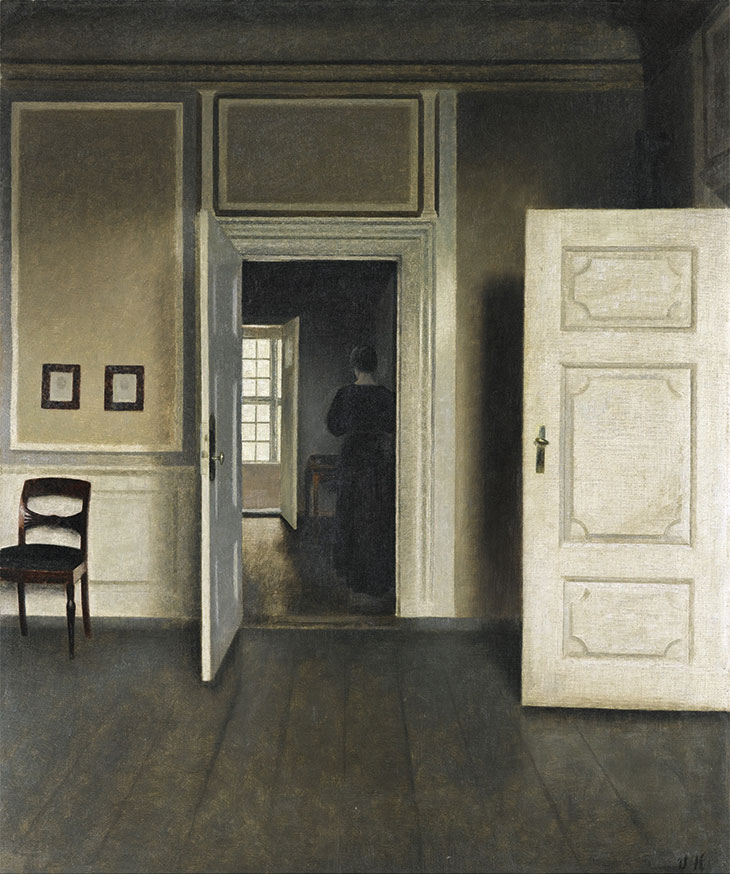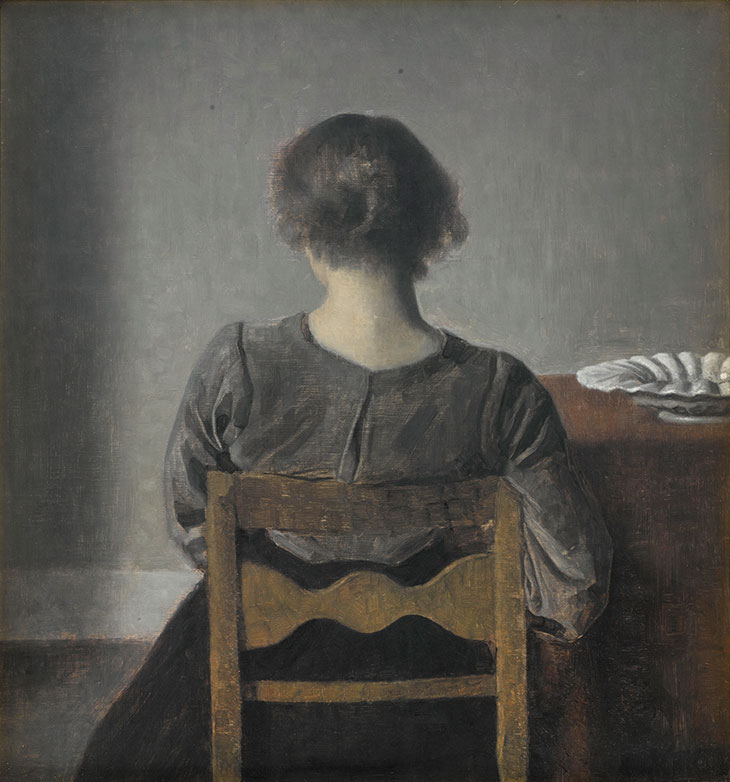The Musée Jacquemart-André on Boulevard Haussmann, in Paris’s eighth arrondissement, seems an odd venue in which to show works by Vilhelm Hammershøi. The 19th-century mansion, once the home of collectors Édouard André and Nélie Jacquemart, is stuffed with art and antiquities: Italian sculpture jostles with rococo furniture, enamelled glass with Japanese lacquer, all of it arranged across ceremonial suites hung floor-to-ceiling with tapestries. Climbing the vast double-helix stone staircase, beneath mirrors and frescos by Giovanni Battista Tiepolo, visitors must navigate this extraordinary house to find the exhibition; on entering, Hammershøi’s small and subdued paintings appear almost catastrophically sobering.
Hammershøi scorned the fussiness with which the bourgeoisie decorated their houses. ‘How much better homes would look,’ he said in an interview, ‘if all this “rubbish” could be got rid of!’ His own apartment, at Strandgade 30 in the Christianshavn district of Copenhagen, was bare by comparison. He moved into the building in December 1898 with his wife, Ida, ordering all the woodwork – panelling, cornicing, door and window frames – to be painted white, the walls and ceilings dove grey, and the floorboards stained dark brown. There, he and Ida lived without clutter, furnishing the rooms with a small collection of things well-loved and old: two sofas, a chest of drawers, some tables, and a piano. Hammershøi loved these rooms for their stateliness, worn a little at the edges, and for the large windows letting in the cold northern European light. Their stillness suited his temperament; he was reclusive, preferring to remain out of view. ‘He spoke slowly and softly,’ wrote Emil Nolde, after visiting Strandgade in 1900. ‘[W]e all spoke quietly.’

Interior with a Windsor Chair (1913), Vilhelm Hammershøi. Ambassador John L. Loeb Jr. Danish Art Collection
The exhibition triumphs in dedicating three rooms to the Strandgade 30 years, which were Hammershoi’s most productive. Of the 370 or so paintings he produced, one third feature the apartment, its white doorways and windowed walls illuminated by the same milky light. Its spaces are at once intimate and anonymous: the wooden step worn down through years of human passage offset by the empty picture frames, the fresh table linen by the unfilled vase. Though Ida is often present, an aproned figure half-turned from view, it’s not her that Hammershøi is painting: he draws attention to the space – to its architectural features, its open doorways leading to other rooms, a network of bare floorboards – but also to its moods, to the weak diffusion of light from unseen windows, the feeling of a cold day. He repeats these images – Interior with a Woman Standing (n.d.), Interior. Strandgade 30 (1901), Interior with a Windsor Chair (1913) – to show variance in sameness, the subtleties of different lights, and of objects in different arrangements. He observes the rooms with the attentiveness of one watching for changes in the weather.

Interior. Strandgade 30 (1901), Vilhelm Hammershøi. Photo: © Städel Museum, Frankfurt/ARTOTHEK
While his contemporaries were experimenting with colour in Paris, Hammershøi was developing an aesthetic of restraint. He worked on his canvases slowly, applying dryish paint in even brushstrokes, layer upon layer until he had captured all the tones of a single colour. Though he was influenced by 17th-century Dutch painting, he was quietly radical, too, rejecting their rosy glow for something more austere. Asked why he used a reduced palette, he replied: ‘I’m utterly convinced that a painting has the best effect in terms of its colour the fewer colours there are.’ Indeed, almost all of his paintings are executed in greys, from blue to ash: the feather in Ida’s hat (Portrait of Ida Ilsted, Future Wife of the Artist, 1890), the flesh of his nudes, the wintry light of his London scenes (The Jewish School in Guilford Street (London), 1912–13). Often, in the last stages of a painting, he would apply a final thin layer of grey over the canvas, enveloping objects and their outlines in a smoky vapour.
Yet for Hammershøi, sticking to one colour was not wilful self-limitation. In his nudes (to which the show dedicates a room) the complexity of his subdued palette reveals itself. In Female Nude (1910), the figure’s skin is ashen, yet stippled by reddish pigment, as if she’s stinging with cold. In Three Studies of a Female Nude (1909–10), a preparatory painting, the brushwork at the edges of the canvas shows the layers of grey: where the colour is deepest, it is a purplish-black, as wet slate; as it softens, it moves from mushroom-brown to the creamy paleness of eggshell and fawn. These are the colours being slowly pulled into perfection, the layers accruing to form the hard cold light of the interior scenes, the shadowy corners, the glinting pewter dishes.

Female Nude (1910), Vilhelm Hammershøi. The David Collection, Copenhagen. Photo: Pernille Kemp
Within grey, Hammershøi plays with contrasts of light and dark: the shining tablecloth with its crisp fold lines in Interior with a Woman from the Back (1898), the luminous wood stove in Interior. Corner of the Dining Room, Strandgade 30 (1899), the chiaroscuro tabletop of Five Portraits (1901–02). His palette allowed him to paint light itself, falling in slats on the floor in Interior, Ray of Sunlight on the Floor (1906), or dancing on the wall in Ray of Sunlight in the Living Room, III (1903). Light is both hard and soft, an elemental part of the painting’s geometry, but also insubstantial, filled with motes.

Hvile (or Rest; 1905), Vilhelm Hammershøi. Musée d’Orsay, Paris. Photo: © RMN-Grand Palais (Musée d’Orsay)/René-Gabriel Ojéda
In these scenes, Ida moves through the rooms, in black dress and apron, an incidental figure caught at the window, or engaged in domestic tasks such as sewing. Hammershøi gives little clue as to her emotions; rarely can we see her face. Instead, we see her during mundane moments, preoccupied, her attention elsewhere. Often she sits with her back squarely to the viewer, as in Hvile (also known as Rest, 1905, the pale skin between her neckline and hairline glowing, the fabric of her dress puckered against the chair. Occasionally, she looks a little trapped, stuck between her sisters-in-law in Three Young Women (1895), their knees grazing each other, or hemmed in by the dining room’s mahogany table and closed doors. Is she happy, floating endlessly through the cold apartment? While critics have assumed her marriage was loveless, circumstances suggest otherwise: when Hammershøi died in 1916, at the age of just 51, Ida had nursed him devotedly through a long illness. Perhaps her inscrutability can be read differently, as evidence of the couple’s privacy, and of the quiet pleasures of life at Strandgade.
‘Hammershøi: The Master of Danish Painting’ is at the Musée Jacquemart-André, Paris, until 22 July.
From the June 2019 issue of Apollo. Preview and subscribe here.














![Masterpiece [Re]discovery 2022. Photo: Ben Fisher Photography, courtesy of Masterpiece London](http://zephr.apollo-magazine.com/wp-content/uploads/2022/07/MPL2022_4263.jpg)
Why it’s time to stop rediscovering Eileen Gray